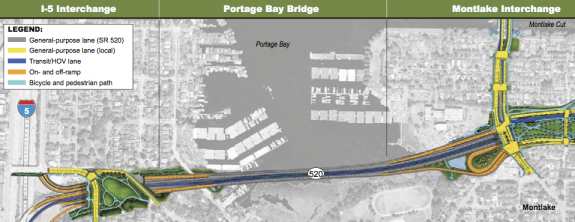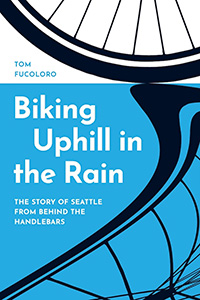 Look, here’s the thing, WSDOT: It would be completely absurd to build a whole new floating bridge from Medina to Montlake complete with a biking and walking trail, then stop the trail less than a mile from the end of the bridge where it can connect to the densest residential neighborhood in the state and bike routes to the state’s largest employment center, downtown Seattle.
Look, here’s the thing, WSDOT: It would be completely absurd to build a whole new floating bridge from Medina to Montlake complete with a biking and walking trail, then stop the trail less than a mile from the end of the bridge where it can connect to the densest residential neighborhood in the state and bike routes to the state’s largest employment center, downtown Seattle.
But currently, the state’s plans do not include a biking and walking facility on the Portage Bay segment of elevated freeway between Montlake and the I-5 interchange near Roanoke Park in North Capitol Hill.
With funding for the 520 Bridge Replacement Project still looking at a $2 billion gap, the state has moved forward with design and public outreach for the project. The state is holding a meeting Saturday, May 19 from 9 a.m. until noon at Seattle Prep.
Swing by and encourage them to design this project with biking and walking as a priority!












Comments
13 responses to “Saturday: Tell WSDOT to build the 520 biking & walking trail to Capitol Hill”
Yes of course they should build it, since not to do so is to dump cyclists out into one of the most congested surface street corridors with travel towards downtown requiring either climbing a big hill or a major backtrack. Building a facility that directly and gradually gets riders halfway up Capital Hill and poised to go downtown or toward Wallingford while bypassing the U-District makes it a useful transportation tool.
My concern however (and this area was my childhood stomping ground and I went everywhere by bike back then) is that they will build it too narrow to be safe: this lane would be analogous to the high-rises of the I-90 floating bridge but much longer – downhill speeds get pretty high. stretch that out to 3/4 mile and they’ll get really high – fine in a travel lane potentially disastrous on a multi-use path.
They have to build it to current bicycle path standards which is 10ft. Shouldn’t be any worse than the current I-90 bridge which feels like 8ft. (Although I haven’t measured it.)
I showed up for this thing and there were lots of people there supporting a bike path. The bike and pedestrian infrastructure table was really the place to be. Also lots of people pointing out the need for good connections from the 520 trail to the BGT and the Lake Washington loop.
As far as I’m concerned, if they’d stop the bike path dead at Montlake they should stop the freeway dead at Montlake, too. No road should ever be built anywhere in the 21st century without direct, straightforward, safe access for pedestrians and cyclists.
Al, you said it right.
I’m guessing that the bicycle and pedestrian access that is provisioned in the new bridge specification is the result of careful scrutiny and input by interested parties relatively early in the design process.
Therefore it seems as though somehow a lapse of attention occurred when it came to applying the same diligence to intermodal traffic once the terminus of the bridge was reached. Not to slight anybody or suggest that an egregious error was made, more that we all have the fault of failing to see transport from a systems perspective, where there are no boundaries between components.
Now here with 520 it’s the same deal as any other systems design challenge where a major oversight is difficult to correct because one component of the system is in implementation mode while the other must somehow be clicked into place, often ungracefully. Not impossible to fix but far more arduous than need be and often resulting in annoying, suboptimal functional compromises.
In a perfect world the Cascade Bicycle Alliance and other interested parties would be organized to pass every single roadway design process and proposed bid specification for roadbuilding projects under their attention– in a formally organized and administered fashion as opposed to piece-wise– and let no project go by without having the bicycle/pedestrian part of the transport system be addressed. There’d be way less frustration and wasted effort trying to put the horse back in front of the cart that way. As it is now, it takes far more energy to correct problems late in the game as opposed to scheduling problems out of existence, early.
The bike advisory board does that well for SDOT projects. However, king county metro and wsdot are not often good at communicating with sbab, and things slip by without advice from the board. Last year’s Howell project is a good example of this. The current Delridge Way project is another.
The state is, well, you know. They should really talk to sbab about every significant project, but they don’t always do that. The Alaskan way detours are a good example of a place where sbab advice could have helped.
So I think the system is in place for what you’re talking about. We just. We’d figure out how to make sure metro and wsdot are consistent about presenting to sbab.
Sometimes this is a symptom of a broader problem of planning projects behind closed doors. Ideally government agencies wouldn’t NEED to inform SBAB and other such groups, because the agencies would always keep the public in general informed and involved at every stage.
To some extent the onus is on planning agencies to “reach out” to interested parties but on the other hand none of these construction projects (even tiny ones invisible next to the 520 plan) appear out of thin air– they’re all disclosed ahead of time, followed by bid invitations. Planning visibility is in fact codified, but without an organized effort to parse public notices there will inevitably be failures of communication.
I wonder if there’s any possibility of an alliance or coalition of extra-automotive transportation interests pooling money to pay a shared staffer to continuously monitor published roadway plans for errors and omissions pertaining to cyclists, pedestrians, etc.?
This could be tricky because as Tom points out there are different levels of jurisdiction involved; how does the city of Index publish plans, for instance? Perhaps EIS filings could serve as a proxy clearinghouse, might be a way of making sure projects rising to a certain threshold wouldn’t be missed?
In any case, a few tens of thousands per year contributed by (??– fill in organizations) arguably could substantially reduce the potential for being surprised and thus having to go into belated plan patching mode. This kind of routine, calmly performed review and input would also inevitably help to inculcate good planning habits on the part of roadway designers.
How often are those plans published, though? I think the first version of the Howell St plan that came to light was also the last one.
The biggest thing, especially if they don’t extend the bike path across Portage Bay, is the presence of a high-quality bike path across the Montlake Bridge, connecting the 520 trail (and the Lake Washington Loop) to light rail and the Burke-Gilman Trail.
[…] community meeting Thursday will discuss plans for the Roanoke lid of the planned (but $2 billion-lacking) 520 Bridge replacement […]
[…] Medina to Montlake as well as new paths in the planned Roanoke lid in North Capitol Hill. However, inexplicably, current designs do not include a bike trail on the short-but-vital segment between Montlake and […]
[…] months ago this victory was a mere flickering hope. Last July, spurred by excellent reporting from Seattle Bike Blog, neighbors flying the flags of Central Seattle Greenways, Montlake Greenways, and […]